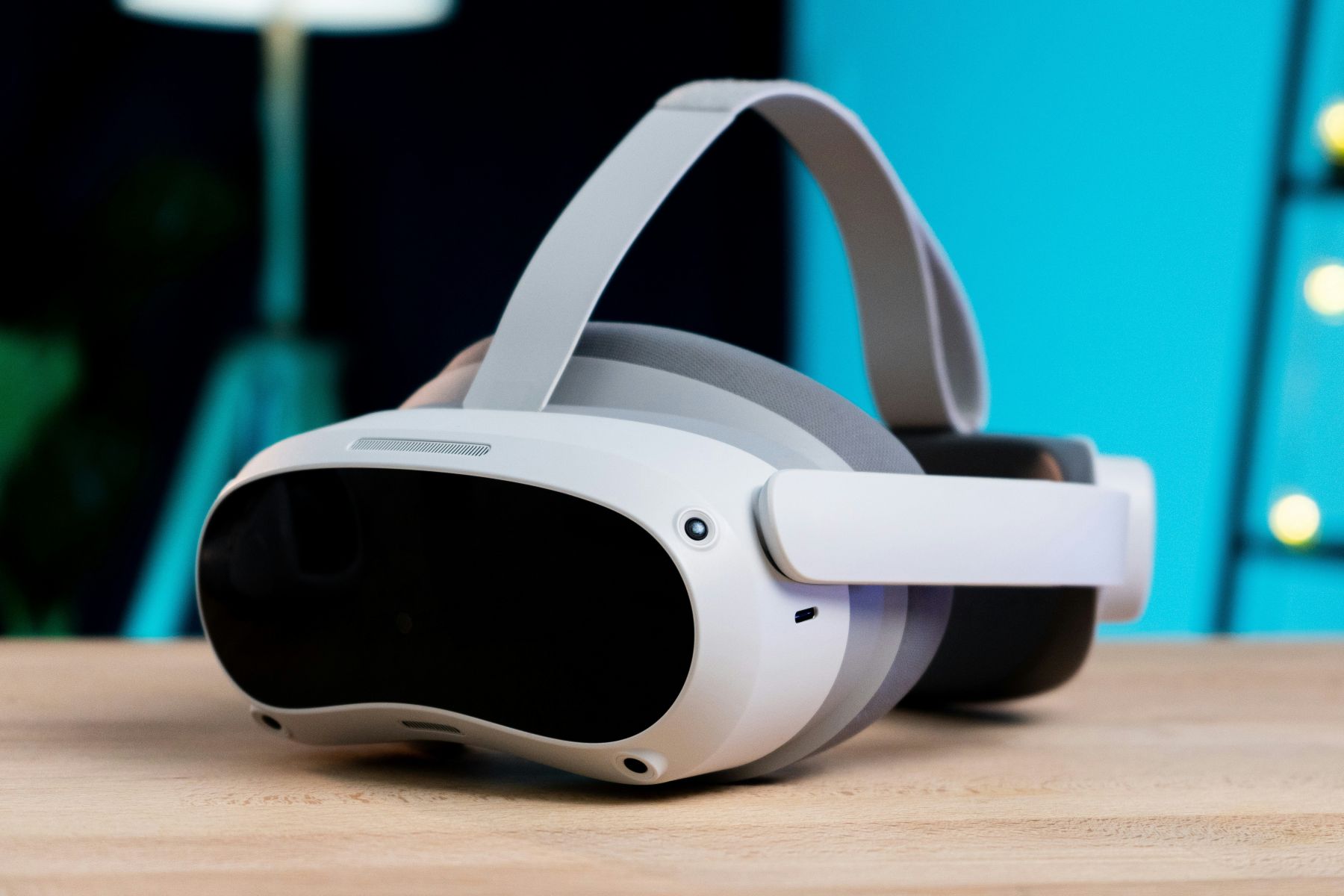2016: The First Generation Problems
To appreciate how far we've come, we need to remember where we started. The 2016-era VR hardware had several fundamental issues:
Resolution and screen door effect: Early headsets had around 1080x1200 pixels per eye. Sounds decent, right? Not when that's spread across your entire field of view. You could literally see the gaps between pixels - what VR enthusiasts called the "screen door effect." It was like looking through a screen door at the world. Reading text was exhausting, and fine details were impossible.
Tethered experience: Every consumer VR headset required a cable connection to a powerful gaming PC. The Oculus Rift needed a $1,000+ computer to run. You'd be immersed in a virtual world, then get yanked back to reality when you stepped on the cable or reached its length limit. Some users even installed ceiling cable management systems to deal with this.
External tracking sensors: The HTC Vive required two "lighthouse" base stations mounted in opposite corners of your room. The Oculus needed multiple sensors plugged into your PC. Setting this up meant drilling into walls, running USB cables, and carefully calibrating everything. Moving your VR setup to another room? Plan to spend an hour reconfiguring.
Weight and comfort: Those first headsets were heavy - around 470-550 grams. Wearing them for more than 30 minutes often resulted in neck strain and red marks on your face. The weight distribution was poor, with most of it sitting on your forehead.
Controller tracking: While the controllers worked, they required line-of-sight to the external sensors. Reach behind your back in VR? Your hand would disappear because the sensors couldn't see the controller.
These limitations meant VR in 2016 was exclusively for enthusiasts - people willing to dedicate space, money, and patience to the experience.
The Breakthroughs That Changed Everything
Several key technological advances transformed VR hardware from a niche hobby to something actually practical:
Inside-Out Tracking (2018-2019)
This was the game-changer. Instead of external sensors tracking the headset, the VR headsets themselves gained cameras that tracked the environment. The Oculus Quest, released in 2019, proved you didn't need a PC or external sensors. The headset could track its own position and the controllers using built-in cameras.
This single innovation eliminated the setup complexity and made VR truly portable. You could take your headset anywhere and play immediately.
Standalone Processing
Modern VR headsets have processors built in - essentially smartphones strapped to your face, but optimized for VR. The Meta Quest 3, for example, uses a Snapdragon XR2 Gen 2 chip that's powerful enough to run impressive VR experiences without any external computer.
This means no cables, no expensive gaming PC, and significantly lower barriers to entry. The entire VR system costs $500-600 instead of $1,500-2,000.
Display Resolution Revolution
Current VR hardware has approximately 4x the pixel density of 2016 models. The Meta Quest 3 has 2064x2208 pixels per eye. The Apple Vision Pro pushes this even further with 3660x3200 per eye.
The screen door effect? Basically gone. You can read text comfortably, see fine details, and the experience feels dramatically more realistic. This resolution improvement alone makes VR practical for productivity work, not just gaming.
Pancake Lenses
This sounds technical, but it matters: traditional VR headsets used thick Fresnel lenses that made the devices bulky. Pancake lenses, now standard in high-end VR headsets, fold the light path multiple times, allowing for much thinner headset designs.
The result? Modern VR headsets are 40-50% thinner than 2016 models, significantly more comfortable, and have better visual clarity edge-to-edge.
Hand Tracking
You don't even need controllers anymore. Modern VR hardware can track your bare hands using the same cameras that handle inside-out tracking. Pinch your fingers together, and the VR world responds. This makes VR feel more natural and reduces the "gearing up" feeling that controllers created.
Passthrough AR (Mixed Reality)
Here's something that didn't exist in 2016: the ability to see the real world through your VR headset. Current VR headsets have color cameras that pass through a view of your actual environment.
This hybrid approach - called mixed reality or passthrough AR - means you can see your keyboard while wearing the headset, place virtual objects on your real desk, or quickly check your surroundings without removing the device. The Apple Vision Pro made this its primary interface, barely feeling like "VR" at all.
The 2025 State of VR Hardware
So what does VR hardware look like today? Let's compare the leading options:
Meta Quest 3 ($500): The mainstream choice. Standalone operation, excellent inside-out tracking, decent passthrough AR, huge app library. Resolution is sharp, comfort is good, and the wireless PC VR streaming option exists for demanding games. This is what VR should have been in 2016.
Apple Vision Pro ($3,500): Premium mixed reality focused on productivity and content consumption. Exceptional display quality, best-in-class passthrough AR, eye tracking for interface navigation. Heavy on features, heavy on price, and honestly heavy on your face, but it showcases where VR hardware is heading.
PlayStation VR2 ($550): Console VR done right. OLED displays with great contrast, eye tracking for foveated rendering, haptic feedback in the headset itself. Still tethered to the PlayStation 5, but the cable is a single, purpose-built connection rather than the mess of 2016.
Valve Index (2019, still sold): Represents the high-end PC VR experience with best-in-class audio, high refresh rates, and finger-tracking controllers. Shows that even "older" modern VR hardware surpasses what 2016 offered.
What This Means for Adoption
The VR hardware improvements aren't just incremental - they've fundamentally changed who can use VR and what it's useful for.
Lower barriers to entry: A complete VR system costs $500 instead of $2,000. Setup takes 5 minutes instead of hours. You don't need a dedicated VR room or gaming PC.
Actually practical for work: Companies are using VR for training, design review, and even virtual meetings. This wasn't realistic in 2016 when wearing a headset for more than 30 minutes was uncomfortable and reading text was painful.
Content creation possibilities: The improved displays and hand tracking make VR development more accessible. Web-based VR (WebXR) works surprisingly well on modern standalone headsets, opening VR to web developers without specialized game engine knowledge.
Real estate and product visualization: Businesses are using VR for virtual property tours and product demonstrations because the visual quality finally matches expectations. Clients can read fine print and see accurate colors.
Why It Still Isn't Mainstream (And What's Next)
Despite massive improvements, VR hardware hasn't become as ubiquitous as smartphones. A few challenges remain:
Social acceptability: Wearing a headset is still isolating. You're cut off from the people around you, even with passthrough AR.
Physical discomfort: Modern headsets are lighter, but 450-600 grams on your head is still noticeable. Long sessions can cause fatigue.
Content library: While much improved, VR still lacks the "killer app" that makes it essential for most people.
Price sensitivity: $500-600 is mainstream-adjacent but not impulse-purchase territory.
The next breakthroughs will likely come from AR glasses - lightweight, socially acceptable devices that blend digital information with the real world without requiring you to strap on a headset. Companies like Meta, Apple, and Snap are all working on these.
The Bottom Line
If you tried VR in 2016 and weren't impressed, give it another shot. Modern VR hardware has solved most of the fundamental problems that made early VR frustrating. The resolution is sharp, the tracking is seamless, the setup is simple, and the experience is wireless.
We're at an inflection point where VR is transitioning from "interesting technology" to "actually useful tool." The hardware finally delivers on the promises made in 2016. Whether you're a business considering VR for product demos, a developer exploring immersive experiences, or just someone curious about the technology, 2025 is a much better time to jump in than 2016 ever was.
The revolution happened quietly, one breakthrough at a time. The result? VR that actually works.



